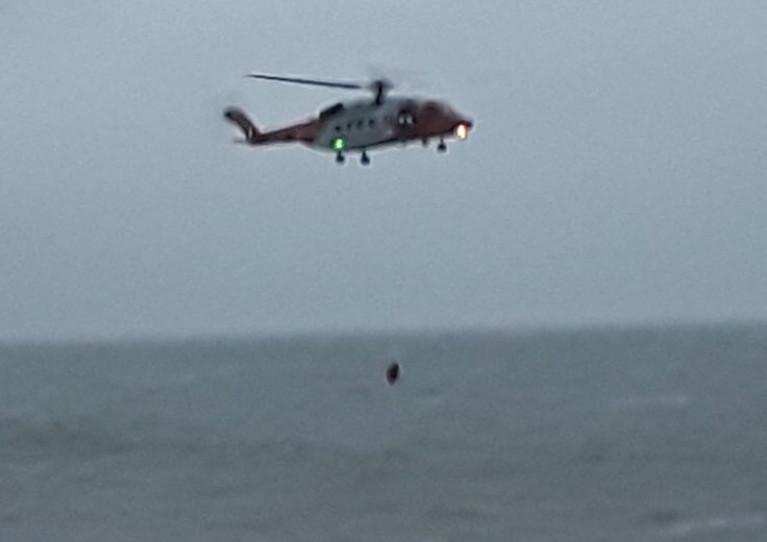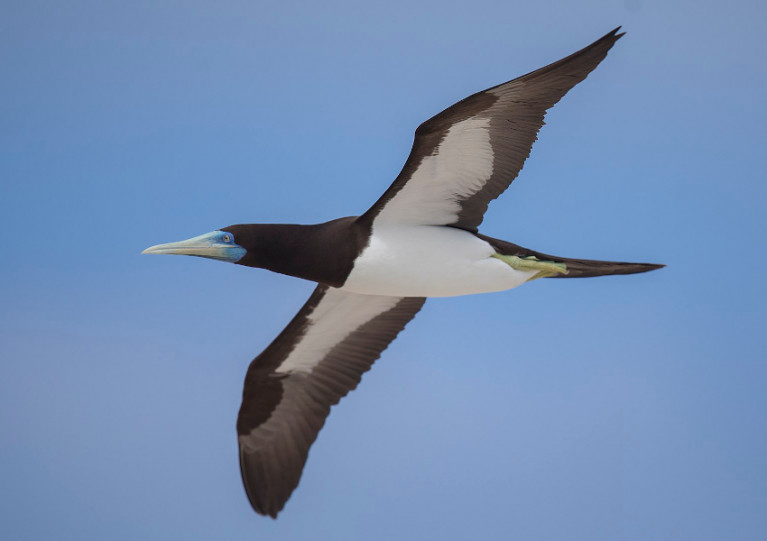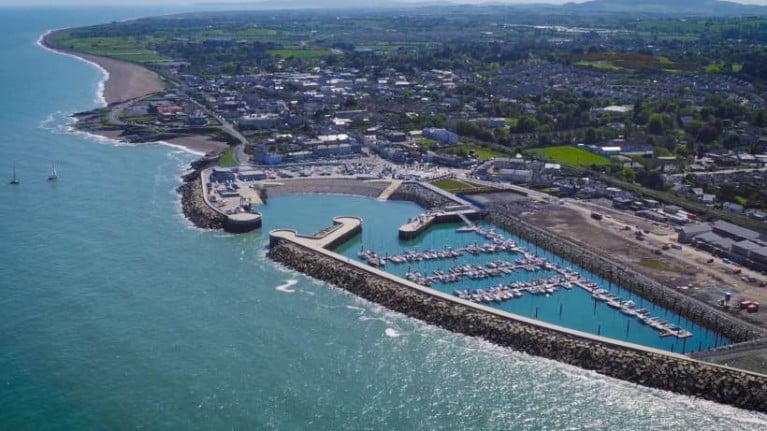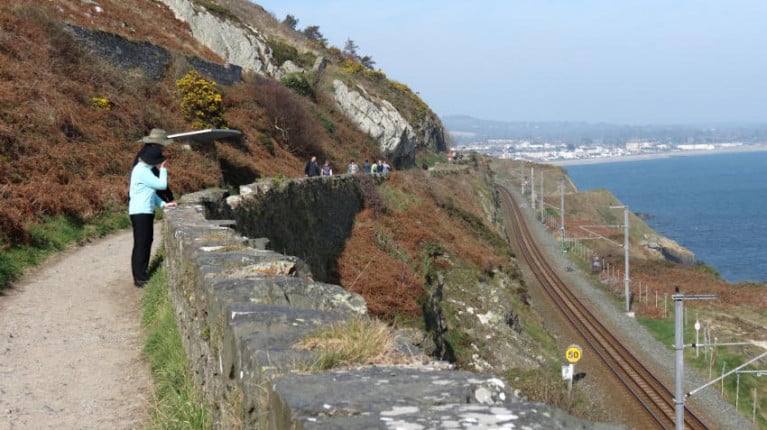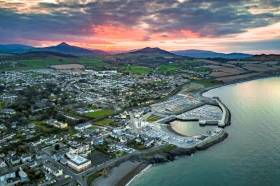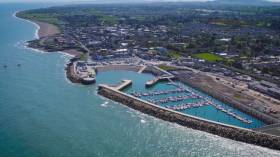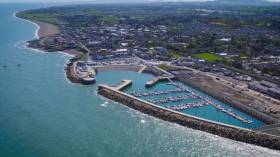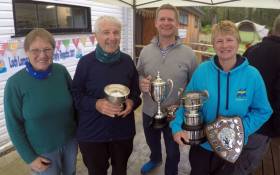Displaying items by tag: Greystones
One Dead After Swimmers Get Into Difficulty Off Greystones
RTÉ News reports that a woman has died after a number of swimmers got into difficulty off Greystones in Co Wicklow earlier today (Saturday 23 April).
The deceased was one of three women in their 50s who were recovered from the water by emergency services in the incident around lunchtime.
A second woman was taken to hospital while the third was treated at the scene. RTÉ News has more on the story HERE.
Shortly after 11 pm this Saturday evening, Wicklow RNLI volunteers were assembling at the lifeboat Station following a Coast Guard pager alert.
Ten minutes later at 11:13 pm Wicklow RNLI all-weather lifeboat slipped its moorings at the south quay and proceeded north to investigate reports of a yacht experiencing difficulties south of Greystones.
The yacht with three people on board was located four miles south of Greystones at 11:45 pm. Weather conditions at the scene were good with calm sea and light airs.
An assessment was carried out and the yacht was found to have a rope fouled in the propeller, efforts were made by the lifeboat crew to free the obstruction, but some rope remained tangled in the propeller shaft. This prevented the engine from being started and the yacht from making its own way to port.
Coxswain Keogh made the decision that undertaking a tow to Greystones harbour was necessary and the safest way to assist the sailors. The yacht was brought alongside Greystones Marina at 00:45 am on Sunday morning and the three sailors landed safely ashore.
The Lifeboat crew then proceeded back to Wicklow harbour arriving back on station at 1:30 am
Speaking after the callout, Wicklow RNLI Press officer, Tommy Dover said: ‘This was the first callout by the all-weather lifeboat crew using the new towing equipment.’
The crew on the callout were Coxswain Nick Keogh, Mechanic Tommy Murphy, Graham Fitzgerald, Paul Sillery, John Stapleton and Ian Thompson.
Coastguard Helicopter Rescues Swimmer in Difficulty off Greystones
The Irish Coast Guard’s Dublin-based helicopter was tasked to the rescue of a swimmer in difficulty off Greystones this afternoon, Wednesday 11 November.
TheJournal.ie reports that the middle-aged woman was one of a number of people swimming in the sea off the Co Wicklow town amid poor weather conditions, with a Status Yellow warning in place for heavy rain.
It’s understood a member of the public entered the water to reach the casualty with a flotation device, but they safely returned to land and the woman was subsequenty winched from the sea by the crew of Rescue 116.
Coast guard pulling someone from the sea in Greystones beach just now. Crazy stuff. @rtenews pic.twitter.com/d4AJvzcLHY
— Hugh Cahill (@hughcahill7) November 11, 2020
TheJournal.ie has more on the story HERE.
Caribbean Sea Bird Causes A Stir On Greystones Beach
Bangor Marina is not the only spot on the island of Ireland that welcomed an unusual winged visitor this week – as locals in Greystones were treated to the sight of a sea bird usually found in the tropical Atlantic.
As RTÉ News reports, the large male brown booby who landed at the beach in the Co Wicklow town this past Tuesday (14 July) was the first recorded signing of the species here.
However, it was later reported that the bird appeared was suffering from exhaustion, likely a result of being blown so far off course by an Atlantic storm, and died in the care of a wildlife rescue centre in Kildare.
Niall Hatch from BirdWatch Ireland commented: “To see one in Europe is really unusual … There’s a record from 2016 on a boat offshore from the Skellig islands but no one got to see it.”
And this bird may not have been alone in his long-distance travels across the Atlantic, as suspected sightings of his fellow brown boobies have been on the rise in waters off southern England and the continent.
RTÉ News has more on the story HERE.
This story was updated on Sunday 19 July.
New Coastguard Station For Greystones Back On Agenda As OPW Lodges Planning Application
The Office of Public Works (OPW) has applied for planning permission for a new coastguard station in Greystones Harbour — three years after plans for the Co Wicklow town were deemed ‘not viable’.
Lack of funds was the reason given for previous proposals grinding to a halt after 12 years of discussions and planning, as reported on Afloat.ie in September 2016.
But now the project is back on the agenda as a planning application lodged recently with Wicklow County Council details revised plans for a single-storey boathouse and vehicle store with accompanying accommodation block.
The proposed building, to the north of Greystones Sailing Club, will have a combined floor area of 259 sq m and a maximum overall roof height of 7.8m above adjacent public space.
The planning application adds: “Proposals include high level windows and three roof lights; proposed external finishes comprise fair faced concrete, zinc roofing and metal framed windows, a new vehicular access point to the north east corner of the site, three flag poles, one radio aerial mast and entrance signage, provision of eight car parking spaces on hard landscaping, [and] associated site works.”
Submissions can be made until Sunday 23 February, and local planners are due to make their decision by Sunday 15 March.
Bray Cliff Walk Is Top Local Attraction For Irish Independent Readers
The cliff walk between Bray and Greystones has been named as Ireland’s favourite local attraction by the readers of the Irish Independent.
The coastal hiking path between the two Wicklow towns placed tops in the newspaper’s Reader Travel Awards for its “amazing views” and energising qualities.
Tidiness long the path and ease of access were also noted by readers — as was the bounty of options for food and drink after a good day’s walk at either end.
Independent.ie has more on the story HERE.
BJ Marine 'Taste of Greystones' Regatta This Weekend Celebrates a Unique Town & Harbour
The problem with Greystones is that it faces the sea writes W M Nixon. Or at the very least, there isn’t a part of the north Wicklow town in which you aren’t very aware that the sea is nearby. The Victorian and Edwardian enthusiasts for sea-air breathing and salt-water bathing who turned this quaint fishing village into a niche seaside resort and healthy residential area would scoff at the idea that always facing the sea in this way was a “problem”. But we’re talking about the optics here, folks.
The thing is that, when you’re in Greystones, you’re somehow unaware that it is located at the heart of one of the most scenically-blessed parts of Ireland. In fact, in looking at a selection of aerial images of Greystones as it snuggles by the coast in close relation to the most wonderful mixture of farm and woodland and uplands and fascinating purple mountains which draw the eye over the hills and far away, you could be forgiven for thinking this is the most beautiful part of Ireland, full stop. And in fact, you might well be right.
Yet in the old days, only the occasional lone aviator and those of us sailing past were fully aware of this magnificent backdrop to the little town. And as the harbour was a somewhat ramshackle affair based around the re-cycling of the failed first attempt to build the Kish Lighthouse (even here, we don’t have the space to tell the full story of that extraordinary saga), any passing cruising yacht was reluctant to go into the tiny, shallow, rough and ready small-boat-packed haven and tell the clientele at the harbourside Beach House what an utterly fantastic place they lived in.
However, some locals did appreciate it properly. Greystones Sailing Club celebrated its Golden Jubilee last year, and among its founder members were the parents of current Irish Sailing President Jack Roy, who cut his own sailing teeth in Greystones, still thinks of the place as home, and was Guest of Honour among a convivial crowd of distinguished folk from every walk of north Wicklow life at the 50th Anniversary party in June 2018.
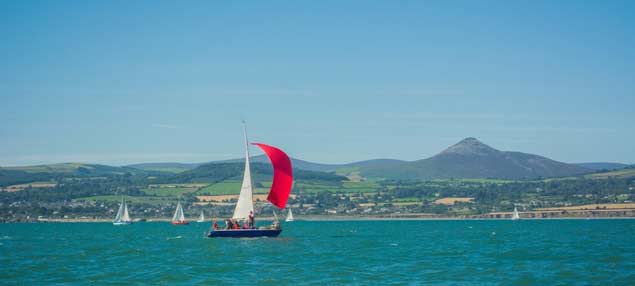 What a backdrop for sailing……Greystones provides good racing off one of the most beautiful coastlines in Ireland, and now it has a proper harbour to facilitate full enjoyment of its attractions and hospitality for visiting boats. Photo GSC
What a backdrop for sailing……Greystones provides good racing off one of the most beautiful coastlines in Ireland, and now it has a proper harbour to facilitate full enjoyment of its attractions and hospitality for visiting boats. Photo GSC
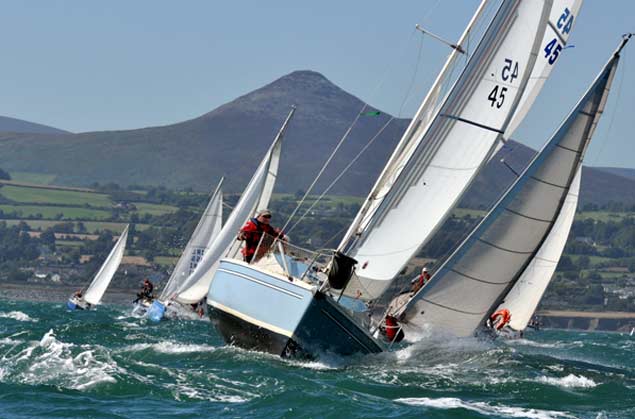 And if anything, that coastline looks even more impressive when there’s a bit of a breeze. Photo GSC
And if anything, that coastline looks even more impressive when there’s a bit of a breeze. Photo GSC
But the Greystones Harbour area of 2018 and 2019 is a very different waterfront place from the Greystones of 1968 when the new sailing club began to stake its claim to a place along the beach and a compound to keep its sailing dinghies, plus a bit of space in the tiny harbour for its flotilla of small cruisers. For Greystones Harbour is now a proper marina with complete shoreside facilities run by BJ Marine and a shared clubhouse beside a spacious and secure dinghy park.
Progress towards this vibrant state of affairs has of course not always been smooth, particularly as key parts of it were happening during the Great Recession of a decade ago. But now, instead of being a place you sailed past and marvelled at the scenery in which it is set, it has become a destination harbour three times over.
For it is not only a strategically located and totally sheltered haven, conveniently near Dublin yet far enough away to stand out as a place in its own right, it’s also a gastronomic destination from land and sea, with attractions to suit foodies and gourmets of all persuasions, together with those who just like a hospitable and friendly place serving decent pints and good home-cooked fare. And on top of all that, Greystones Sailing Club has become a pace-setter on the national scene.
Commodore Daphne Hoolahan leads an enthusiastic membership with a formidably talented lineup of specialist officers, and while it may be unfair to single out individuals, when you have people of the calibre of Monica Schaefer as Honorary Sailing Secretary and Daragh Cafferky as the man in charge of keelboats and clubhouse matters, not to mention Norman Lee as Honorary Club Bo’sun in addition to managing the dinghies, then it’s clear we’re dealing with efficient can-do people, rather than dreamy ’twill-do folk.
The results bear it up. Just last weekend, Greystones’ own Shane McCarthy, crewed by clubmate Damien Bracken, regained the Irish GP 14 National title in blustery conditions at Skerries against a truly international fleet which reflected the fact that in 2020, Skerries will be hosting the International GP 14 Worlds.
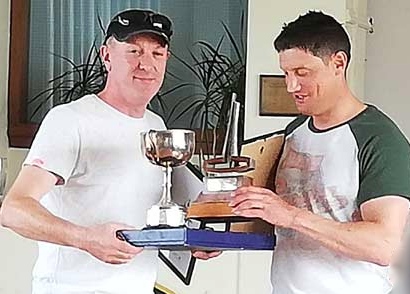 Damien Bracken (left) and Shane McCarthy of Greystones with their trophies after the latter had helmed their way to overall victory from an international fleet at the Irish GP 14 Nationals in Skerries last weekend. Photo SSC
Damien Bracken (left) and Shane McCarthy of Greystones with their trophies after the latter had helmed their way to overall victory from an international fleet at the Irish GP 14 Nationals in Skerries last weekend. Photo SSC
But Skerries can only envy Greystones in its soaring success, for the Fingal port bears much the same relationship to the Greater Dublin area to the north as Greystones does to the south. Yet while Skerries continues to struggle to persuade the powers that be that its primitive harbour badly needs development to allow water and boat sports to grow properly and safely, Greystones sails securely on with confidence in a proper harbour.
And 2019 saw the Greystones hosting of a world dinghy championship too. The fact that it was the Wayfarer Worlds in July is in the best-established traditions of Greystones as something of a niche place, for the superb 16ft Ian Proctor-designed Wayfarer would be much more popular globally if more people were aware of its exceptional versatility - excellent club racing and a record of Icelandic and trans-North Sea voyaging are only two of its many attributes.
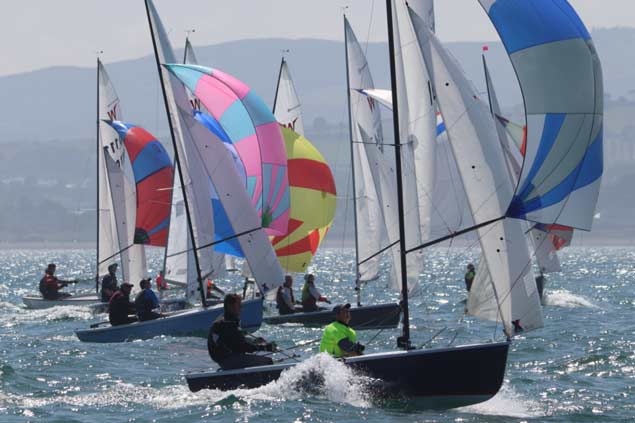 The versatile Wayfarers having magnificent sailing in their Worlds at Greystones, July 2019. Photo Alan Jones
The versatile Wayfarers having magnificent sailing in their Worlds at Greystones, July 2019. Photo Alan Jones
But Wayfarer people are a special crowd, they prefer personal quality to mindless quantity in the crews they race against. Yet even with that selective approach, the 2019 International Wayfarer Worlds attracted a cracking fleet of 53 quality boats from seven nations on both sides of the Atlantic, and while UK crews made up the bulk of the visitors, there was a very strong turnout from Denmark.
Yes, Denmark…..world leaders in the marine industry, yet the Danes have the savvy to cop on that the Wayfarer is something very special. And it makes this an extraordinary week on Afloat.ie. For we can go for months with little mention of Denmark apart from the occasional reference to the Irish success of some Danish-built X Yacht. Yet in recent days, we’ve carried a story about how the rape and pillage of the Vikings (many of whom were Danish) actually did a world of good for the degenerating Irish genetic line (something which, as the home of the world’s leading equine bloodstock industry, we should truly appreciate), we’ve also carried the story of how gallant little Denmark on behalf of its large island of Greenland has said thanks but no thanks to Donald Trump’s offer to buy Greenland even as our own beloved ketch Ilen of Limerick was port-hopping along the Greenland coast, and now we are reminded again that it is the Danes who are among those who best appreciate the virtues of the Wayfarer dinghy.
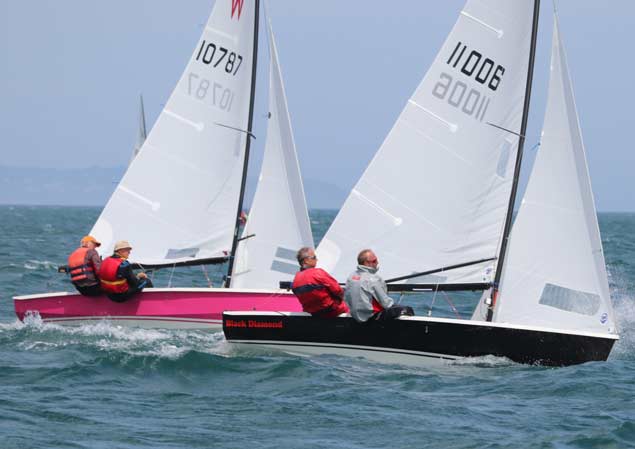 Beware. The Danes are on the coast……Stephan Nandrup-Bus of Herselve Strand Sailing Club in Denmark, crewed by Hans Wiggens Hansen in 11006, looks to have things comfortably in control off Greystones over clubmate Jan Kjeldsen crewed by Jorgen Blitzer in 10797. But in the end, Kjeldsen was 9th overall while Nandrup-Bus was tenth. Photo Alan Jones
Beware. The Danes are on the coast……Stephan Nandrup-Bus of Herselve Strand Sailing Club in Denmark, crewed by Hans Wiggens Hansen in 11006, looks to have things comfortably in control off Greystones over clubmate Jan Kjeldsen crewed by Jorgen Blitzer in 10797. But in the end, Kjeldsen was 9th overall while Nandrup-Bus was tenth. Photo Alan Jones
In fact, they almost won the Wayfarer Worlds at Greystones in July. Mogens Just and Anders Frils from Kalovig Badelaug in Denmark won the first race, and they logged two more wins and a second and third before being pipped at the post by the legendary sailmaker Mike McNamara of Rollesbury Broad SC in the heart of England’s Norfolk Broads, crewed by Simon Townsend.
Sailing Wayfarers keeps you young – Mike McNamara is reputedly 76, but his performance afloat belies it, and his performance to finish with a final score of 7 points to the 8 of Mogens Just said most things. Yet despite his Irish name, it couldn’t be claimed as a home win, for he operates as the sixth generation of sailmakers in the family firm, and six generations away from the McNamara heartlands around Lisdoonvarna and Ennistymon in north Clare is a very long time indeed.
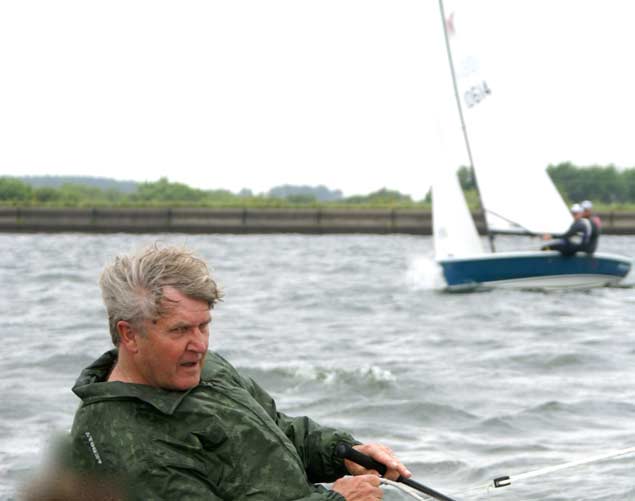 “My name is McNamara, I’m the leader of the band….” At the age of 76, veteran sailmaker Mike McNamara became the 2019 Wayfarer World Champion by just one point from Mogens Just of Denmark.
“My name is McNamara, I’m the leader of the band….” At the age of 76, veteran sailmaker Mike McNamara became the 2019 Wayfarer World Champion by just one point from Mogens Just of Denmark.
But at Greystones while McNamara and Townsend may have won by one point from the Danish Just/Fris crew, although two UK helms – Andrew Whitney and Bill Wilson – were next in line, the Danes then took seven places in a row in the shape of Niels Aislev (5th), Bjarne Lindquist (6th), Christian Elkjaer Iverson (7th), Christian Milert Hansen (8th), Christian Milert Hansen (9th), Jan Kjeldsen (10th) and Stephan Nandrup-Bus (11th), making it the most successful yet friendly Viking invasion on the Wicklow coast in a long time which the Irish had to accept gracefully, our best place being first in the Silver Fleet for the host club’s John Turner and Ken Lee, but in a fleet of this calibre that made them 15th overall. Full results here
Just to look back on the photos of the sunlit Wayfarer Worlds at Greystones in July is a real tonic after the cold and heartless weather of August. But for this weekend’s multi-dimensional Greystones Regatta – sponsored by BJ Marine and in association with Taste of Greystones - the seemingly unstoppable Greystones good fortune looks like returning with Indian summer conditions, and everyone is mad keen to make the best of it at this jewel of the Wicklow coast.
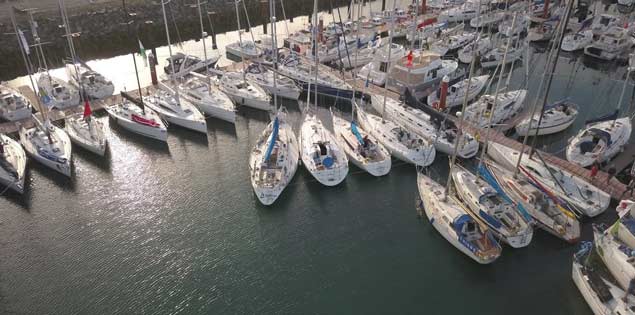 It’s regatta time, so they pack them in for sociable berthing in Greystones
It’s regatta time, so they pack them in for sociable berthing in Greystones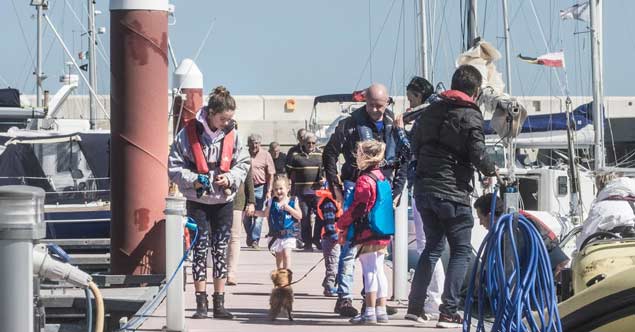 And the pooch comes too. The BJ Marine Taste of Greystones Regatta Weekend may see some serious racing, but it’s a family event as well
And the pooch comes too. The BJ Marine Taste of Greystones Regatta Weekend may see some serious racing, but it’s a family event as well
It is certainly rating very high with the cruiser-racing crowd, for the success of Greystones’ own Frank Whelan with his young crew on the keenly-campaigned Grand Soleil 44 Eleuthera - for two years and more now - brings heightened respect for the entire Greystones sailing scene. The word is that at least two of the classic Half Tonners associated with Howth – Dave Cullen’s Checkmate XV and Nigel Biggs’ Checkmate XIII - are going to make a proper weekend of it, while ISORA’s time-honoured annual James C Eadie Cup Race is being tailored in such a way that the leaders, having started in Dun Laoghaire at 1000 hrs, should be getting to the finish line at Greystones around 1600hrs this afternoon in an updated version of the ISORA feeder race which last year was won by Chris Power Smith’s J/122 Aurelia.
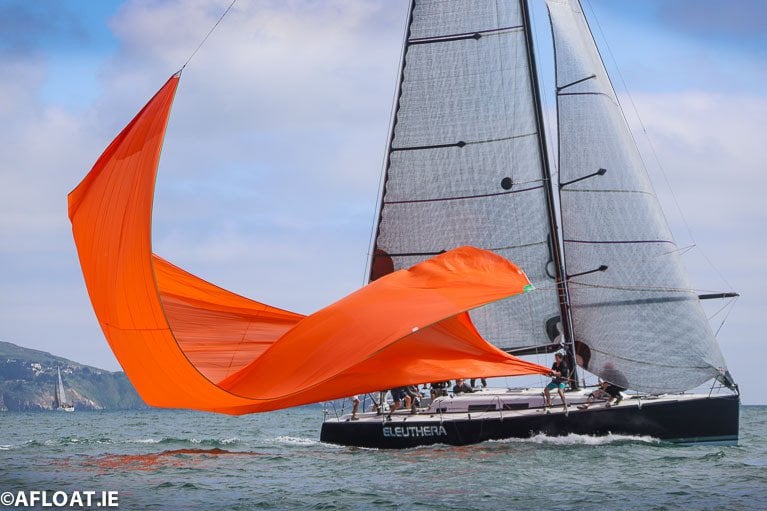 Champion for Greystones – Frank Whelan’s Grand Soleil 44 Eleuthera (GSC) on her way to one of many race victories in 2019. Photo Afloat
Champion for Greystones – Frank Whelan’s Grand Soleil 44 Eleuthera (GSC) on her way to one of many race victories in 2019. Photo Afloat
Meanwhile the Dublin Bay Sailing Club fleet will be limbering up towards their usual Saturday starting sequence around 1400 hrs, but in this instance the finish will be at Greystones, bringing upwards of 70 boats from Dun Laoghaire, while additional feeder races from both Clontarf Y & BC and Poolbeg Y & BC will make Greystones Harbour a distinctly busy and convivial place this (Saturday) night.
Tomorrow (Sunday) the hope is to fit in two races with a reasonably early conclusion in five classes under ECHO, making it a hectic weekend for the volunteer element in Greystones SC, for the club’s total membership is around the 360 mark. The demand for the proper Committee Boat starting line means that Daragh Cafferky won’t be able to race his own A35 Another Adventure (just back from a “hugely enjoyable” visit to West Cork and Calves Week), as Another Adventure has to serve as Committee Boat, but needs must.
Last year Pat Kelly’s J/109 Storm from Rush and Howth was top boat overall and winner of Class 1 to win the Taste of Greystones Trophy, with second OA going to sister-ship White Mischief (Tim Goodbody, RIYC), while Dermot Cafferky’s Another Adventure was allowed at the racing in 2018, and was rewarded with third overall.
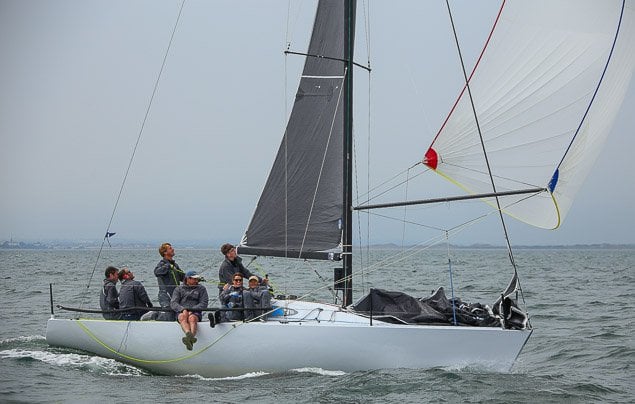 Nigel Biggs’ classic Half Tonner Checkmate XVIII was winner of Class 2 sailed by Ronan Keating at Greystones Regatta 2018. Photo: Afloat.ie/David O’Brien
Nigel Biggs’ classic Half Tonner Checkmate XVIII was winner of Class 2 sailed by Ronan Keating at Greystones Regatta 2018. Photo: Afloat.ie/David O’Brien
Class 2 went to Checkmate XVIII, while James Kirwan’s First 36.7 Boomerang of RStGYC and Greystones was second and local boat Virgin Triangle (Graham Noonan) took third. In Class 3, Brendan Foley’s impressively-optimised Impala 28 Running Wild (RStGYC) won out from Barry Cunningham’s Quarter Tonner Quest (RIYC) while Luke Fegan’s Hustler 32 Smokehaze, all the way down from Malahide, was third.
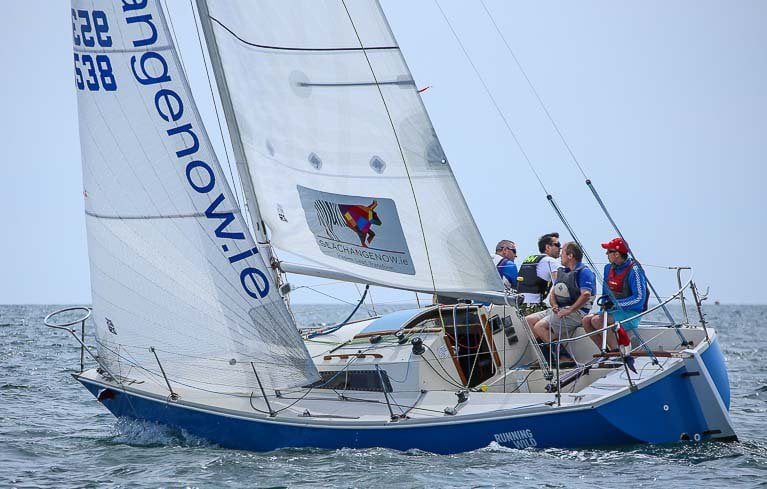 Brendan Foley’s impressively optimized Impala 28 Running Wild (RStGYC) took the Class 3 title at Greystones last year. Photo: Afloat.ie/David O’Brien
Brendan Foley’s impressively optimized Impala 28 Running Wild (RStGYC) took the Class 3 title at Greystones last year. Photo: Afloat.ie/David O’Brien
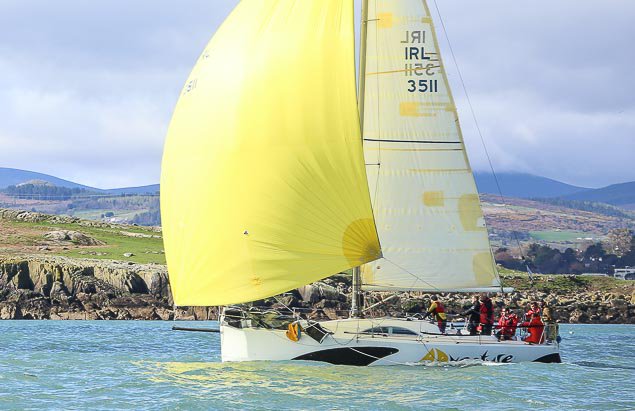 Daragh Cafferky’s A35 Another Adventure was on the podium at the 2018 Greystones Regatta, but this weekend she is doing duty as Committee Boat. Photo: Afloat.ie/David O’Brien
Daragh Cafferky’s A35 Another Adventure was on the podium at the 2018 Greystones Regatta, but this weekend she is doing duty as Committee Boat. Photo: Afloat.ie/David O’Brien
In White Sails Class 4, the Byrne family’s Jeanneau 34 Alphida from Howth was tops with Elantic (C Allen, Arklow SC) second and the Greystones boat Run’n’L8 (C McGuire) third, while in White Sails Class 5 J Raughter’s Chase Me from Bray took the title from E Lynch’s Alfresco from Wicklow, with another Bray boat, Fegan’s Nymadzi, getting third.
The impressive range of the prize winners’ home ports, from Arklow in the south to Malahide in the north while including every sailing centre in between, speaks volumes about what a marvellous celebration of East Coast sailing and its shoreside hospitality the Taste of Greystones has become.
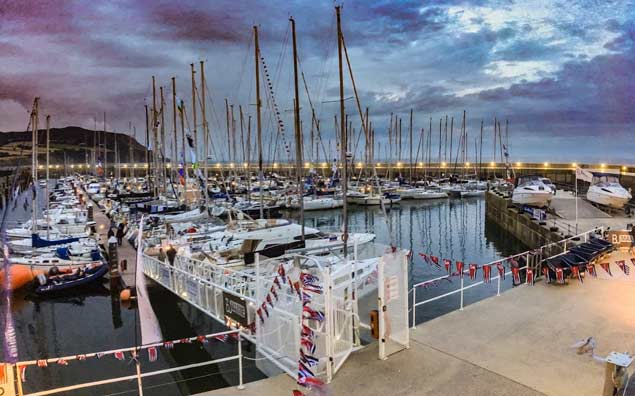 Regatta evening – the day’s sport is complete, and the harbour is full
Regatta evening – the day’s sport is complete, and the harbour is full
Yet just to show that this weekend’s popularity of Greystones Harbour isn’t a flash in the pan, in a week’s time the Irish Cruising Club will be holding its Annual East Coast Rally at Greystones, while thanks to the foul weather of mid-August, the annual Greystones Junior Regatta originally scheduled for August 18th had to be postponed, and is still something to be keenly anticipated.
And as a continually repeated theme underlying all sailing and boating, there is now the enduring fact that Greystones has become a very useful port of call for cruisers as they make their quiet way up and down the coast. Those of us with a taste for the East Coast for a long time always had to admit that while it was beautiful to look at and sail along, you were distracted from enjoying its beauty by concerns about how far it was to the next safe haven, particularly if the weather was acting up. The arrival of Greystones Marina has been transformative. We can only hope that its success will encourage other currently inadequate East Coast ports to see where their best future is to be found.
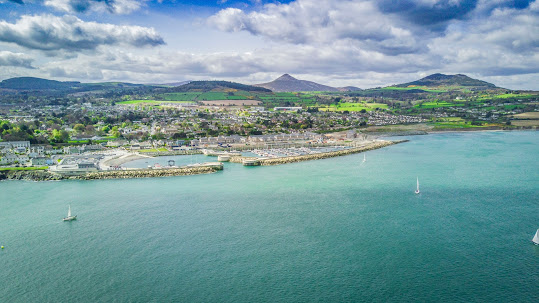 This weekend, Greystones is the focal point for East Coast sailing, and an example for other harbours in need of development
This weekend, Greystones is the focal point for East Coast sailing, and an example for other harbours in need of development
Fishermen’s Blockade Of Greystones Harbour ‘Toned Down’ With Assurance Of Meeting To Discuss Grievances
The Irish Times reports that a planned blockade of Greystones Harbour in a row over access for local fishermen was “toned down” as a meeting to discuss their issues was arranged for this coming week.
Last month, it was reported that a group of 10 fishermen claimed they had been effectively shut out of the Co Wicklow harbour since its €300 million redevelopment.
Some 10 years after they were asked to leave the harbour on what they contend was a temporary basis, the fishermen staged a flotilla protest yesterday, Saturday 22 June.
But this was de-escalated when local councillor Tom Fortune arranged for both sides in the dispute to meet at Greystones Municipal District Offices this coming Thursday afternoon.
The Irish Times has more on the story HERE.
Greystones Fishermen Protest As Redeveloped Harbour Leaves No Room For Commercial Fleet
Recent redevelopment of Greystones Harbour has effectively shut the fishing industry out of the Co Wicklow town, local fisherman have told The Irish Times.
A group of 10 fishermen say they were promised new arrangements when the €300 million development scheme went ahead with a new marina, waterfront plaza amenities and luxury homes.
But they contend that the agreed space was used for a commercial boat yard, and instead they were offered ‘swing’ moorings within the harbour which were not considered safe to use.
While most of the boats have since moved to Wicklow town or Dun Laoghaire, a number of skippers say they will make a point of landing their catches on the beach in Greystones Harbour in protest at their exclusion.
The Irish Times has more on the story HERE.
Greystones Helmswoman is on the Wayfarer Podium on Both Sides of the Atlantic
Greystones Wayfarer helmswoman Monica Schaefer has rounded out a remarkable racing season with a successful defence of the Scottish title on Loch Lomond writes W M Nixon. This means that she now has the triple, having won the Irish title during the Volvo Dun Laoghaire Regatta in July, and then topping the Silver Fleet at the UK Championship.
But those are only Monica’s successes on this side of the Atlantic. The Wayfarer class’s international links are strong, and she was offered a boat to race in the North Americans in Toronto. Despite being noted for the devoted way she prepares her own boat W11152, she responded to the challenge of a strange boat in strange waters by finishing third overall.
Her most recent success has been retaining the Scottish title, and for this event she’d her own boat, and was crewed by Neil McSherry. He is best known for his involvement with the Shipman 28 Class in Dublin Bay through the National Yacht Club, but is also a Wayfarer fan, and brought the bonus of being Scottish, so he provided a certain level of local knowledge.
A two day event saw the Schaefer boat getting a good lead with two bullets when two races could finally be sailed on the Saturday after a breeze eventually filled in, with second place held by local crew Bob and Margaret Sparkes. After a fine evening of Scottish hospitality complete with singing and dancing, Sunday dawned bright, but the Loch was like glass with no wind at all.
The AP was up and racing postponed for about an hour when a nice breeze filled in, with the Race Committee doing well to get three races under way in quick succession. Conditions were a bit tricky with positions on the beat constantly changing with massive wind shifts. The leaders played it safe up the middle, roll-tacking on every shift to maximise momentum and wind lift advantage. This tactic paid off handsomely and they finished all three races at the front to give them a clean sweep of five races and the Championship honours.
The positions overall were 1st W11152 (Monica Schaefer (Greystones SC) & Neil McSherry (National YC)); 2nd (and first Scottish boat W6117 (Bob & Margaret Sparkes (Loch Lomond SC)); 3rd W7588 (Dawn Crow and Jackie Meldrum (LLSC))


























